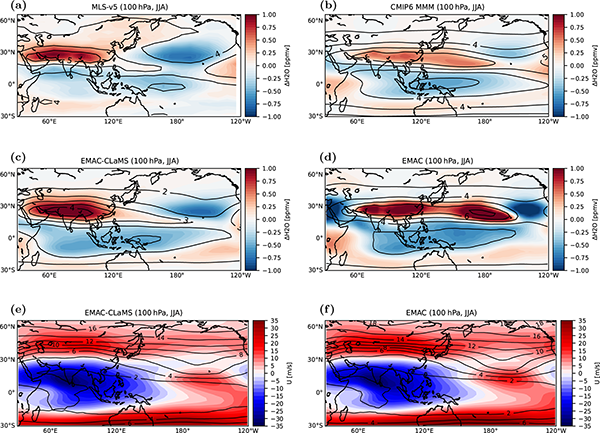New Highlight paper by Ploeger et al. in Atmospheric Chemistry and Physics

The authors present a novel mechanism of how regional anomalies in water vapour concentrations in the upper troposphere and lower stratosphere impact regional atmospheric circulation systems. These impacts include a displaced upper-level Asian monsoon circulation and strengthened prevailing westerlies in the Pacific region. Current climate models have biases in simulating these regional water vapour anomalies and circulation impacts, but the biases can be avoided by improving the model transport.
https://doi.org/10.5194/acp-24-2033-2024
Executive editor’s statement: There is a very strong contrast between water vapor concentrations in the stratosphere (dry) and the troposphere (moist). Climate models typically represent this contrast poorly and suffer from a ‘moist bias’ in the extratropical lower stratosphere. Here two versions of a particular model, one a standard version and the other with a different transport scheme which greatly reduces the moist bias, are used to give a clear demonstration of its effect, through the radiative effects of water vapor, on the regional-scale tropospheric circulation in the Northern Hemisphere Pacific region. The authors then show that differences in moist bias explain differences in this circulation across a large set of climate models. Improvements in transport schemes and hence better representation of the troposphere-stratosphere contrast in water vapor are likely to improve important regional scale features of the tropospheric circulation.
Abstract:
Water vapour in the upper troposphere and lower stratosphere (UTLS) is a key radiative agent and a crucial factor in the Earth’s climate system. Here, we investigate a common regional moist bias in the Pacific UTLS during Northern Hemisphere summer in state-of-the-art climate models. We demonstrate, through a combination of climate model experiments and satellite observations, that the Pacific moist bias amplifies local long-wave cooling, which ultimately impacts regional circulation systems in the UTLS. Related impacts involve a strengthening of isentropic potential vorticity gradients, strengthened westerlies in the Pacific westerly duct region, and a zonally displaced anticyclonic monsoon circulation. Furthermore, we show that the regional Pacific moist bias can be significantly reduced by applying a Lagrangian, less-diffusive transport scheme and that such a model improvement could be important for improving the simulation of regional circulation systems, in particular in the Asian monsoon and Pacific region.
The publication is available as open access: Ploeger, F., Birner, T., Charlesworth, E., Konopka, P., and Müller, R.: Moist bias in the Pacific upper troposphere and lower stratosphere (UTLS) in climate models affects regional circulation patterns, Atmos. Chem. Phys., 24, 2033–2043, https://doi.org/10.5194/acp-24-2033-2024, 2024.
See the news item at Atmospheric Chemistry and Physics. © Author(s) 2024. This work is distributed under the Creative Commons Attribution 4.0 License.
